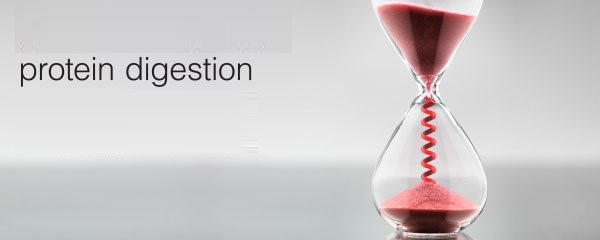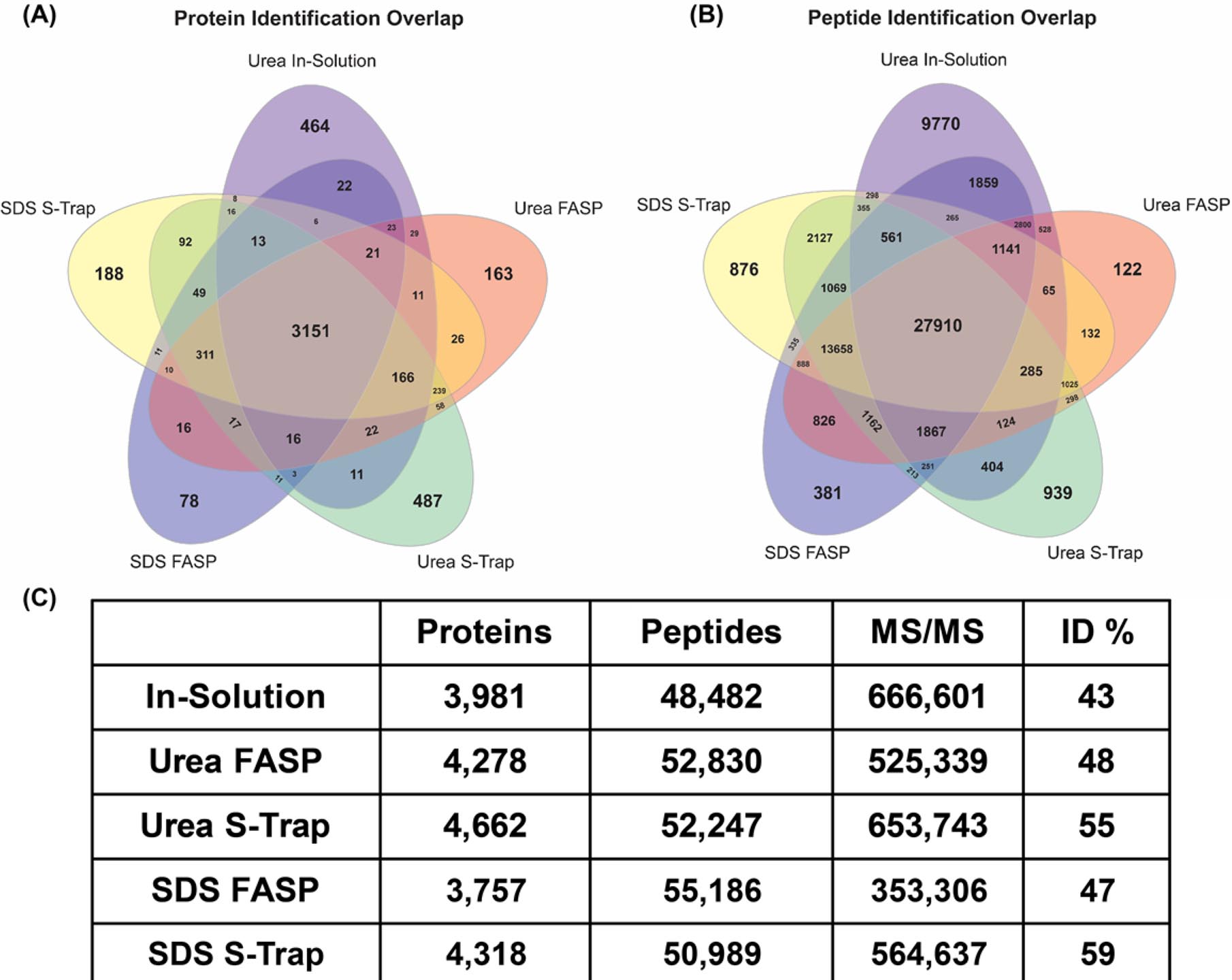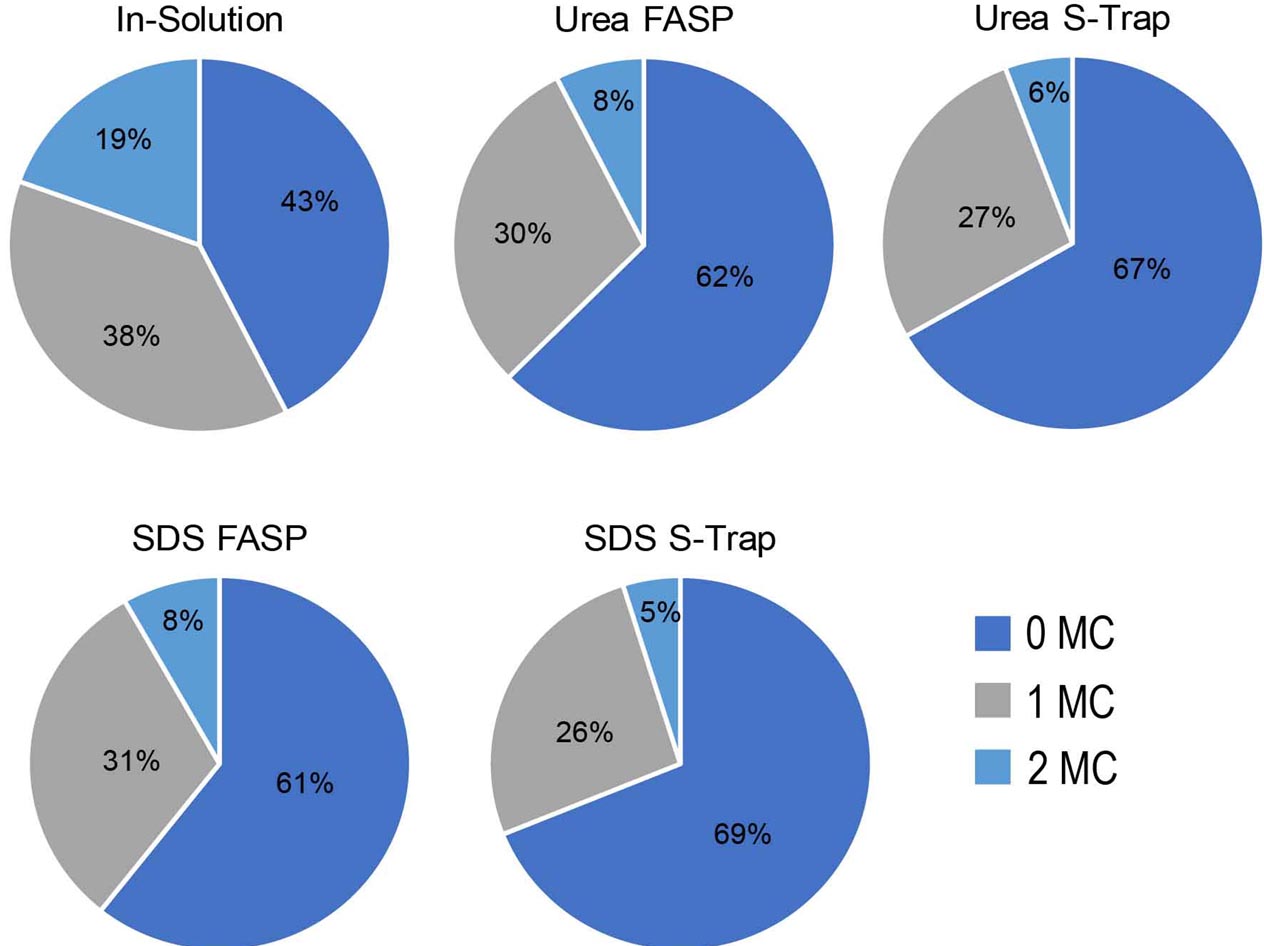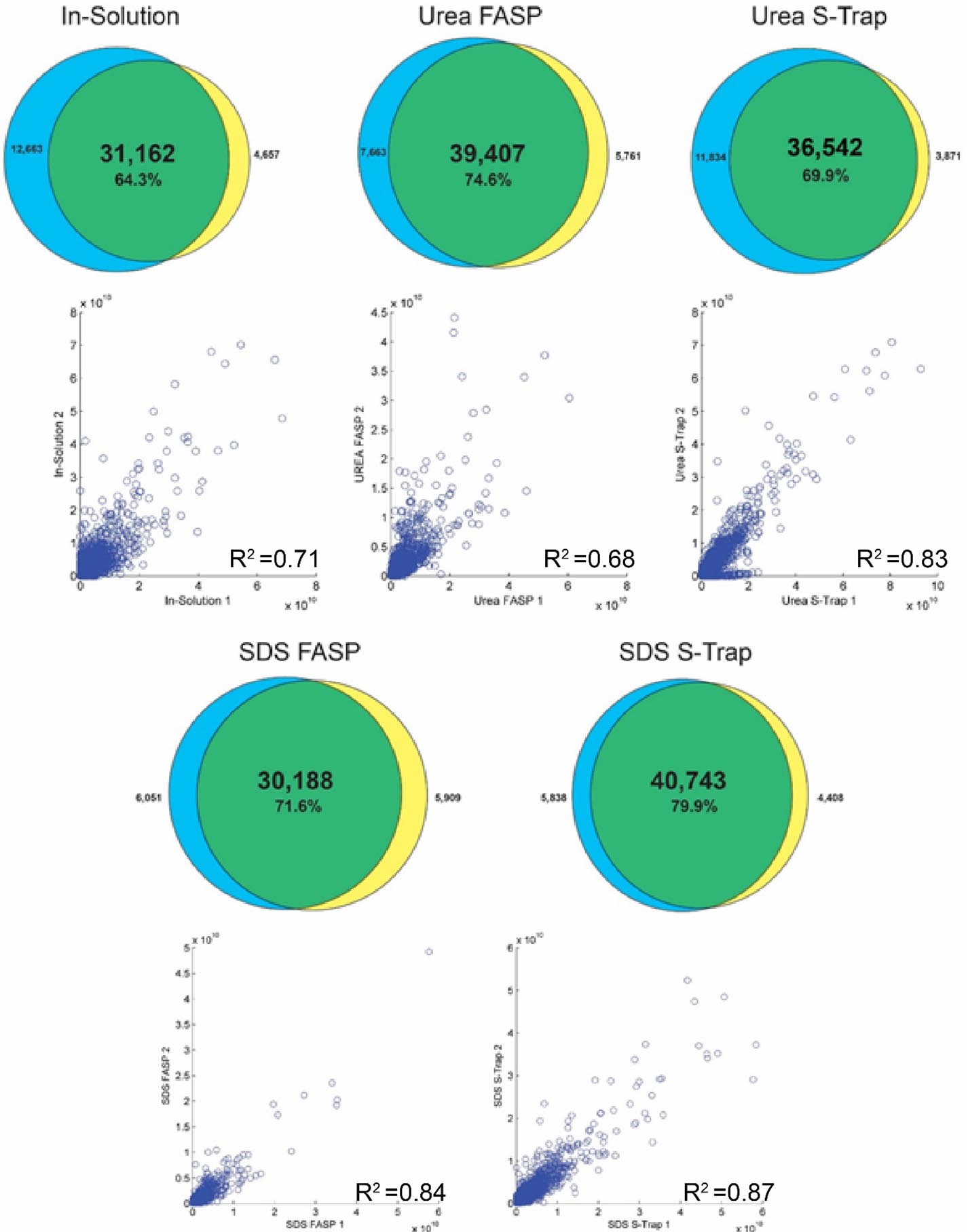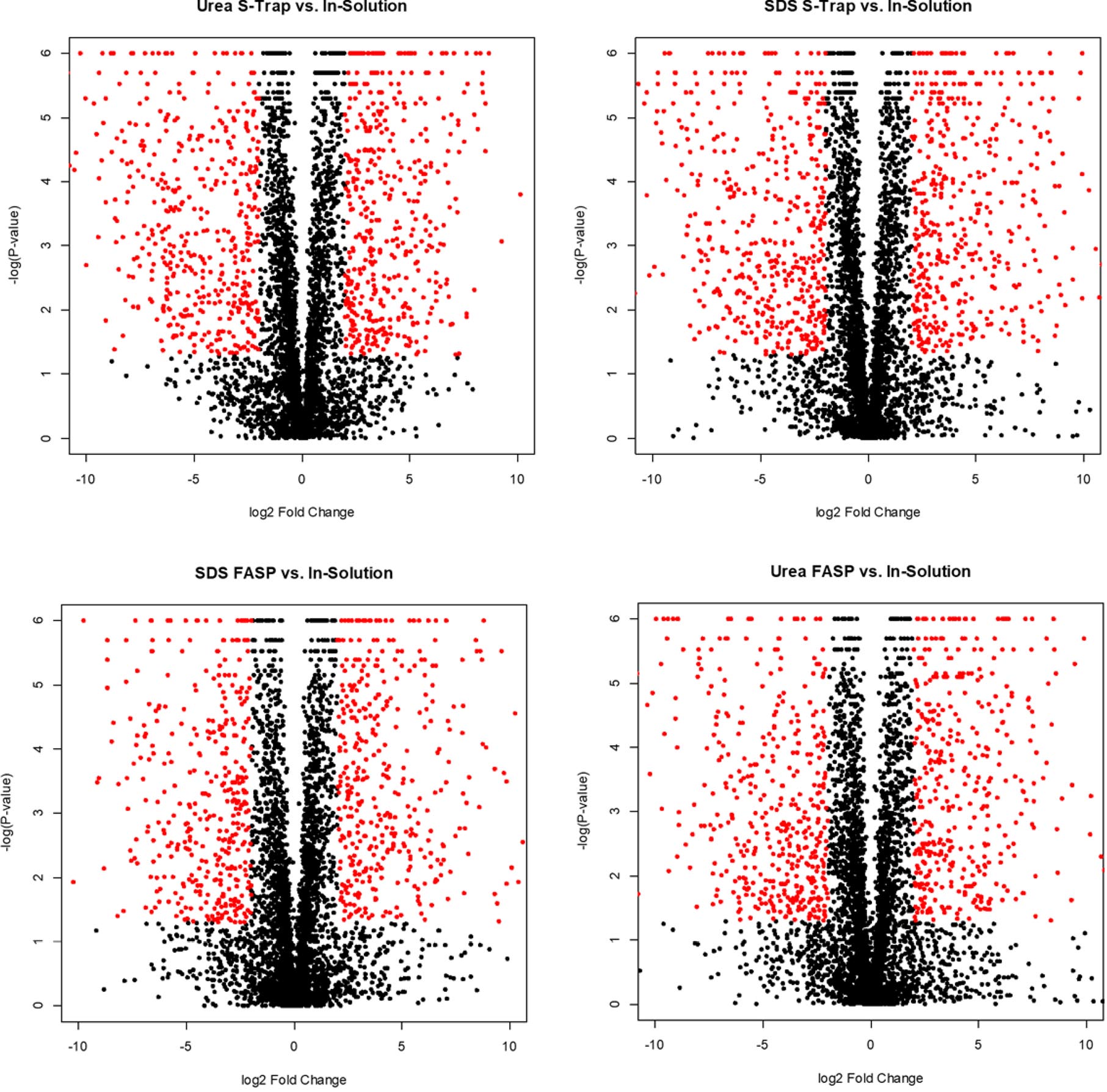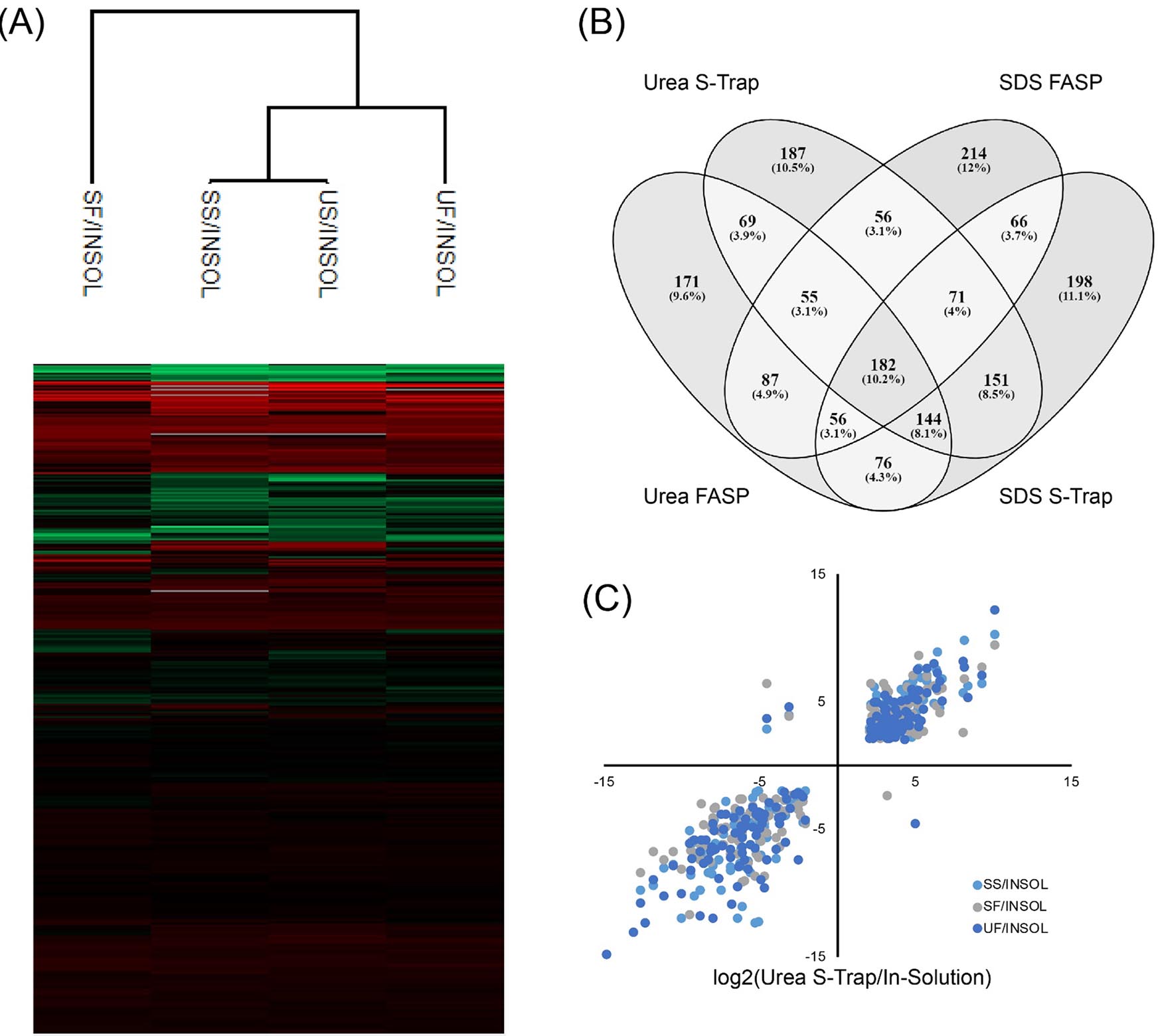博文
工具篇:质谱上机前酶解处理方法之比较
||
通过高效液相串联质谱(LC-MS/MS)对生物系统中全蛋白进行定性定量,已经成为一种主流的分析工具。 大规模的蛋白组研究通常依赖于蛋白被消化成肽段,然后进行后续的定性定量分析。因此蛋白的消化效率对于后续质谱实验至关重要,质谱的结果与样本类型,裂解条件,酶解消化和分馏方法等等密切相关,最近有一些研究比较了裂解,酶解和分馏的条件下鉴定蛋白的效果。实验室最常见的溶液酶切手段是FASP(filter-aidedsample preparation),当然随着实验手段的进步,最近S-Trap(Suspension trapping)方法也是一种比较便捷的酶切手段,当然还有最传统的In-solution酶切的方法。 有一篇名为《Comparison of In-Solution, FASP, and S‑Trap Based Digestion Methods for Bottom-Up Proteomic Studies》比较了FASP,S-trap和In-solution三种不同的酶切方法下(后文附三种酶切方法的protocol)。对SW480细胞进行质谱分析,分别做定性与定量的比较,探索三者之间的蛋白鉴定差异,以及评估三种不同方法情况下,生物学样本质谱分析结果的重复性及稳定性。 蛋白与肽段的鉴定 首先分别含有5% SDS和8M尿素溶液对人SW480细胞进行裂解,随后用In-solution,FASP和S-Trap三种方法消化用8M尿素裂解的蛋白,而SDS裂解的蛋白只能用FASP和S-Trap进行酶解,整个实验流程详情见图1。
图1 随后蛋白都用高效液相进行分离,并串联QE质谱仪进行后续分析。接着使用Maxquant进行搜库分析,比较三种不同酶切方法所定性蛋白与肽段的区别,如图2所示。
图2 整体上,S-Trap方法所鉴定蛋白(8M尿素)数目是4662个,是鉴定到数目最多的一组,然后FASP方法所鉴定蛋白(SDS)数目最少,是3757个。S-Trap(8M尿素)和in-solution(8M尿素)两种方法消化后所鉴定到最多的独有蛋白数目,这很有可能是因为S-Trap(8M尿素)这种方法能够得到总量更多的蛋白所引起的。但是 in-solution法(8M尿素)所鉴定也有同样数量的蛋白个数,因此推断以过滤法为基础的酶切方法和以溶液为基础的酶切方法所获取的蛋白组分是不同的。 在图2B中是每种方法所鉴定的肽段信息的比较,S-Trap(SDS)和S-Trap(8M尿素)所得独有的肽段比用FASP(SDS或者8M尿素)方法多,但是 in-solution方法鉴定到最多的肽段数目,共有9770个,在这个9770个肽段中有9318个胰酶漏切位点,因此这也就是说虽然得到了这么多的独有肽段,但是也未能得到较多的蛋白鉴定数目。 紧接着作者又进一步探索了各种酶切方法中漏切位点的比较,如图3所示。
图3 FASP和S-trap的胰酶漏切位点比例分别是61%和69%,然而in-soluton的比例仅有43%。In-solution方法中有20%的肽段具有2个漏切位点,而另外两种只有5%-8%的肽段有这样的情况,这么大的差别很可能是因为胰酶的浓度差别导致的。In-solution 这种方法会稀释胰酶的浓度,因此FASP和S-Trap两种方法更适合全蛋白组分析和特定肽段定量分析。作者还比较了不同方法下蛋白的理化性质,以及裂解液的差别,均未发现有任何明显趋势变化,推断三方法只在胰酶酶切效率和鉴定蛋白个数上有显著差异。
Lablefree定量分析差异 接着通过使用Maxquant进行定量统计分析,图4中比较了三种不同方法的蛋白差异,S-Trap消化过程中,发现其重复性最好,然后in-solution的重复性最差,重复性的比较是根据maxLFQ软件中蛋白丰度进行比较的。 图4 在基于过滤酶切方法中,重复之间呈线性相关,R2数值在0.94与0.98之间,in-solution的相关性较弱,R2值只有0.74. 图5是又从肽段水平进行的比较,发现此趋势与前面蛋白之间比较较为吻合,S-Trap方法的重复性较好,而in-solution的重复较差一些。 图5 图6是作者采用火山图的方法描述不同酶切方法之间的蛋白定量差异,可以看出红色点是差异明显的蛋白(log2>2或log2<-2,且p-value<0.05),明显看到在不同酶切机制,所鉴定到的蛋白组差异也非常明显。然后图7中 发现样本平行重复之间并未有明显差异。
图6 图7 通过热图,韦恩图等分析三种方法件的蛋白差异,发现S-Trap的酶切方法的重复性较好,与in-solution酶切方法比较,发现每种方法都能鉴定到特有的一组蛋白,后面又对4种方法共同鉴定的182个蛋白进行分析,与in-solution相比发现具有相同的表达趋势,可能是基于过滤酶切方法的系统性误差引起的。 图8 蛋白溶液酶解如何选? 通过对几种不同酶切方法的比较,发现S-Trap(SDS)和S-Trap(8M 尿素)要比FASP和in-solution的酶切效果好,不管从蛋白定量重复性还是蛋白鉴定个数方面都占优。S-Trap(8M 尿素)方法鉴定到4662个蛋白,但是传统的in-solution方法之鉴定到3981个蛋白。同时,FASP(SDS)只鉴定到3757个蛋白,FASP(SDS)鉴定到了4278个蛋白,说明FASP酶切的重复性较差一些。基于发现肽段的漏切位点个数,S-Trap是效率最高的酶切方法。
每一种酶切方法各有优劣,in-solution法比较时间费用性价比较高,但是鉴定蛋白数目少且重复性较差。FASP方法虽然十分高效,但是耗时长,并且还需要承担过滤的费用成本,且不同的裂解配方(SDS和8M尿素)所鉴定的蛋白不同。最后,S-Trap法展示出其较优的特点,省时,鉴定蛋白数目多,虽然美中不足的是耗费时间较长,但综合来看此方法从操作性,时间成本,费用支出等平衡性最好的酶切手段。因此建议定量蛋白组学方面的科学家可以采取此法作为优先选择对象。 附:三种酶切方法步骤
In-Solution Sample Preparation
Suspension-Trapping (S-Trap) Preparation
Filter-Aided Sample Preparation (FASP)
�原文链接� AIMS---蛋白质谱服务商,提供快速便捷的 LC-MS/MS 蛋白定性/定量检测。(官网建设中) |
https://blog.sciencenet.cn/blog-3402731-1148232.html
上一篇:干货篇:蛋白质谱之“搜库”
下一篇:【讨论篇】定量蛋白质组学:在基础科研和医疗应用中的机遇与挑战
